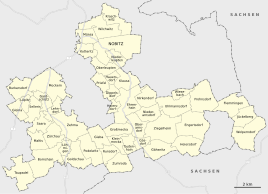Uhlmannsdorf
|
Uhlmannsdorf
community Nobitz
Coordinates: 50 ° 55 ′ 57 ″ N , 12 ° 33 ′ 24 ″ E
|
|
|---|---|
| Height : | 225 m above sea level NN |
| Residents : | 60 (2012) |
| Incorporation : | July 1, 1950 |
| Incorporated into: | Brick home |
| Postal code : | 04603 |
| Area code : | 034494 |
|
Location of Uhlmannsdorf in the unified municipality of Nobitz
|
|
|
View of the northern location
|
|
Uhlmannsdorf is a locality of Ziegelheim in the municipality of Nobitz in the Altenburger Land district in Thuringia . The place was incorporated into Ziegelheim on July 1, 1950, with which it came to the Nobitz community on July 6, 2018. Uhlmannsdorf belonged to Saxony until 1952 due to its historical affiliation with the Ziegelheim manor .
geography
Location and traffic
Uhlmannsdorf is still in Altenburg's most redeemed hill country south of the Leinawald . In the south, the place merges directly into the place Ziegelheim. The national highway 180 affected south-west the room. With the district roads 202 and 203 the community is opened up to traffic. Between 1901 and 1995, the Boderitz station on the Altenburg – Langenleuba – Oberhain line was north of the town . The historical affiliation and state border to Saxony is only visible today in the affiliation of the place to the parish of Ziegelheim in the church district of Glauchau-Rochlitz of the Evangelical Lutheran regional church of Saxony .
Neighboring places
| Nirkendorf | Boderitz | Wiesebach |
| Niederarnsdorf |

|
Frohnsdorf |
| Brick home | Engertsdorf (formerly: Hinteruhlmannsdorf) |
history
The place was first mentioned on March 23, 1254. Uhlmannsdorf was in the north of the Ziegelheim manor , which was owned by the Lords of Schönburg as a Saxon fief . Ecclesiastically, Uhlmannsdorf has always been part of Ziegelheim. After 1813, the Ziegelheim patrimonial court was administered by the Schönburg Justice Office in Remse . The relationship between the Kingdom of Saxony and the House of Schönburg was reorganized in 1835. The Schönburg-Waldenburg areas, which were under Saxon feudal rule, such as the Remse rule and the Ziegelheim manor, were placed under the administration of the Zwickau Royal Saxon Office . On September 25, 1856, the judicial powers of the Ziegelheim manor, as well as those of the Remse manor, were ceded to the Saxon state. Uhlmannsdorf was administered by the Remse judicial office until the administration in the Kingdom of Saxony was reorganized in 1875 . From 1875, the places of the former lordship of Ziegelheim belonged to the Zwickau administration . After an administrative reform was carried out in the area of the Schönburg recession in 1878, they came with the entire former judicial district of Remse in 1880 to the newly founded Saxon governorate of Glauchau . From 1918 on, Uhlmannsdorf belonged to the Free State of Saxony.
In contrast to the three places Frohnsdorf , Heiersdorf and Gähsnitz / Jesenitz of the former lordship of Ziegelheim, which were divided between Saxony and Thuringia until 1928, the completely Saxon Uhlmannsdorf remained after the exchange of territory and the border adjustment between the Free State of Saxony and the state in 1928 Thuringia untouched.
On July 1, 1950, it was incorporated into Ziegelheim . During the second district reform in the GDR in 1952, the existing states were dissolved and the districts were redesigned. Thus, the previously Saxon communities of Ziegelheim and Gähsnitz came to the district of Leipzig with the Altenburg district , which was detached from its area historically belonging to Thuringia . As part of the Ziegelheim district of the municipality of the same name, Uhlmannsdorf has belonged to the Thuringian district of Altenburg since 1990, which was added to the district of Altenburger Land in 1994. In 2012 60 people lived in the district. On July 6, 2018, the municipality of Ziegelheim was incorporated into Nobitz, making Ziegelheim with Uhlmannsdorf and Thiergarten part of the municipality of Nobitz.
Born in Uhlmannsdorf
- Heinz Wildenhain (* 1927), former SED - official
Web links
- Uhlmannsdorf in the Digital Historical Directory of Saxony
Individual evidence
- ↑ Representation of the Waldenburg region with the parish of Ziegelheim on the website of the Evangelical Lutheran Church of Saxony
- ^ Wolfgang Kahl: First mention of Thuringian towns and villages. A manual. Rockstuhl Verlag, Bad Langensalza 2010, ISBN 978-3-86777-202-0 , p. 291
- ↑ Historical table sheet from 1874 with the political situation around Ziegelheim
- ↑ The Ziegelheim manor in the “Monograph on the princely and counts house Schönburg”, p. 51
- ^ Components of the Remse Justice Office in the "Handbuch der Geographie", p. 410
- ^ The Schönburg rule of Waldenburg in the archive of the Free State of Saxony
- ↑ Incorporation of the Remse rule with the Tirschheim and Ziegelheim dinghies in the Zwickau district directorate, “Handbook of the royal Saxon legislation of January 28th and 30th, 1835”, p. 132
- ^ The Ziegelheim court as part of the Zwickau office in the book "Geography for all Stands, p. 635"
- ↑ Ziegelheim in the "Handbuch der Geographie", p. 149
- ^ The Zwickau Office in the Archives of the Free State of Saxony
- ↑ The Glauchau administrative authority in the municipal register 1900
- ^ Map with the exchange areas between Saxony and Thuringia in 1928
- ↑ Uhlmannsdorf on gov.genealogy.net
- ↑ Thuringian Law and Ordinance Gazette No. 7 2018 of July 5, 2018 , accessed on July 6, 2018


